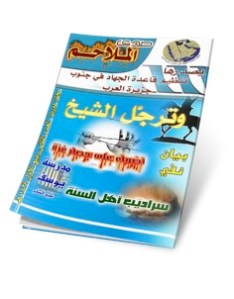
The image is an e-cover of the AQAP magazine Sada al-Malahim, issue 2, Rabi` al-Awwal 1429 A.H. [March/April 2008 C.E.]. In the top left appears the magazine’s name Sada al-Malahim ablaze and dripping blood. Under that and from right to left the caption reads: “yusdiruha tanzim al-qa`idat al-jihad fi janub jazirat al-`Arab” [“(Sada al-Malahim) published by Qa`idat al-Jihad (the jihad base) in the Southern Arabian Peninsula”]. The same caption appears in the AQAP logo in the top right corner – a globe with the Arabian Peninsula landmass, a black banner bearing the shahada (Islamic testimony of faith – There is no god but Allah and Muhammad His messenger) with the seal of the Prophet and two crossed Arabian swords.
The various captions in the bottom section of the cover are the names of the different articles that appear in the issue: “wa-tarajjal al-shaykh” [“and the shaykh alighted (got off his horse; referring to Abu al-Layth al-Libi and his death)”], “bayan nafy” (denial statement), “adwa’ `ala hisar ghaza” [light(s sic.) on the Gaza siege], “saradib ahl al-sunna” (“Sunnis’ underground bunkers/vaults”); “madrasat ysuf, `layahi al-salam” (“the Yusuf school of thought, peace be upon him”).
The yellow and red of the flames in the image invoke pain of separation, a longing to be united with God, that is, the longing for death and achievement of martyrdom. The fiery red of the dripping blood resonates passion, impulse and danger. It is fundamentally linked to the vital force, and to warlike qualities. The image of barbwire is often used in jihadi imagery, particularly in the context of the Palestinian jihad against the Israeli/Jewish enemy to signal the oppressive nature of the enemy; the urgency of the call to jihad in that arena and evidence for its legitimacy. Behind the caption “madrasat yusuf” in the bottom left appears a partial image of prison cell bars. This portrays the main subject of the article on jihadis’ prison experiences and ways to view it as a blessing from God (or simply avoiding it by obtaining martyrdom, see issue 2 (April 2008), p. 19).
 Skip to content
Skip to content
